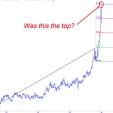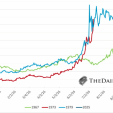When Not To Trade
You might remember being excited last Monday when the Silver market had a strong down day. You were possibly observing price movements more engaged than on typical trading days. On volatile or strong directional days one feels more compelled to execute trades. However, it is important to know when not to trade.
Our mind gets stimulated for various reasons:
- computer screens more actively flickering
- possible price level alerts triggered in your charting software
- increased news and rumor releases
- increased posting frequency in trading related social media channels
- your mind asking for whys and whens
In short, an increased data density per time segment triggering data overload and curiosity on data evaluation. The biggest culprit of creating stress is elevated emotional states of “fear of missing out” and “uncertainty”. While times like these might require your action of taking partial profits or otherwise exits, these times are certainly not times to enter into a position. The market is either high volatile trading wide range sideways in which case you do not want to get chopped out or has a strong directional move and you do not need to step in front of the train.
Silver, Daily Chart, Ten percent range, when not to trade:
Silver in US Dollar, daily chart as of November 12th, 2020
On Monday the 9th of November, Silver prices took out five prior session closing prices. The daily range was close to ten percent. What typically happens is hours of observation by the trader without suitable low risk points to join the bears. In frustration he enters the market for a long position hoping for a price reverse. Fighting a strong intraday trend is in most cases futile. The trader ends up with losses and often even tries numerous times to find the bottom throwing good money after bad. To avoid such traps we post in our free telegram channel the daily call. A “weather” forecast that points out what not to do for the upcoming trading session. Preplanning one’s daily actions like this supports avoiding emotional reactionary trading behavior. Protecting capital is key!
The daily chart above also shows the volume change once we traded above the US$20 mark. As well, orange dotted lines illustrate the general bullish note Silver continues to follow since March of this year.
Silver, Weekly Chart, Pat – no game:
Silver in US Dollar, weekly chart as of November 12th, 2020
Stepping up a time frame we find a weekly chart that has no trade setups. A volume analysis over the data sample of this year’s trading provides a point of control near US$24. With prices at this level, bears and bulls are in a pat position. This doesn’t allow a contrarian to place true low-risk bets for this window of weekly position plays and discipline requires to step aside.
What spikes curiosity is the fact of a steady increase in the average volume increase (orange line above volume bars). One can see that interest in Silver has increased and we are repeating ourselves stating that we find an accumulation of a physical Silver position to be a very good wealth preservation strategy.
Silver, Monthly Chart, Away from the noise:
Silver in US Dollar, monthly chart as of November 12th, 2020
One way to escape trading traps at times of high volatility is to remind oneself of core fundamental reasons why holding physical Silver is of high value and stepping up to higher timeframes and longer-term plays. Silver is called the little brother of gold and this almost gives it a belittling connotation. When looking closer the effective practical use of this metal is way more substantial than the one of Gold. The versatility of Silver is enormous. Used in the brazing and soldering as well as photography, the solar industry, and TV’s/ phones, it is an essential material needed daily. In the pharma industry, it is essential for sterilization, as an antibiotic to just name a couple.
We have made a volume analysis of Silver over the entire data sample of the last fourteen years. The result is solid support right below the US$20 mark. Likewise, we analyzed a volume data sample from September 2010 to May 2013 representing all prices trading above the US$19.70 support. It came as no surprise that the result of a distribution zone arose right near the recent highs with US$28.82.
This leads us to a large time frame play of entries anywhere near US$24 or lower (yellow box). Applying our quad exit strategy, we would have a 1:1 risk/reward ratio (or better), between our stop and our financing target (sell 50%). A 1:5 risk/reward ratio towards our next exit and a 30 or higher target for our runner portion of the trade (based on our Fibonacci extension final target projection which is not show in this chart).
When not to trade
On volatile or strong directional days one feels more compelled to execute trades. The energy built up from data overload causes an urge to release such energies by pushing the button and becoming part of the action. This is precisely not the time where you want to be executing. With data overwhelm, the brain acts most of the time on intuitive impulses. This fight-flight reaction typically being a sound decision causes in trading behavior the worst results. The market is in principle a counterintuitive environment that punishes the undisciplined with losses. Getting chopped out or catching the falling knife costs you dearly.
This energy built up can spill into the next day’s trading session. And again one loses money since choppy days come in sequence and after extreme directional days typically a small range sideways day follows, scarce of good low-risk opportunities. Avoid reactionary play triggered by emotions due to volatility increase. Master your states with a clear set of rules aligning with your mental make-up on what the course of action in detail will be. Especially on these more active days in the market.
We post real time entries and exits for the silver market in our free Telegram channel.
If you like to get regular updates on our gold model, precious metals and cryptocurrencies you can subscribe to our free newsletter.
*********



















